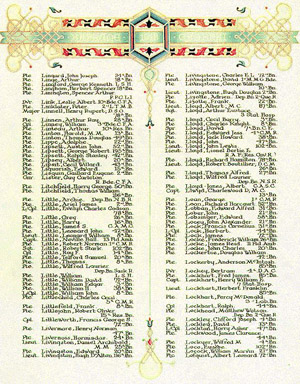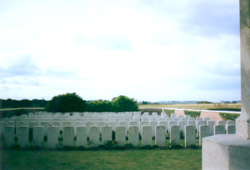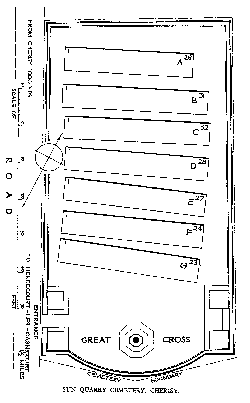

In memory of
Private
GRAY LITTLE
March 17, 1892 - August 28, 1918
Military Service
Service Number: 445112Age: 26
Force: Army
Unit: Canadian Infantry (New Brunswick Regiment)Division: 26th Battallion
Commemorated on Page 450 of the First World War Book of Remembrance.
Medium sized pop-up image
541 X 692, 96 dpi, 169 k
Military Attestation papers:
When a recruit signed up for the Canadian Expeditionary Force in WW I he filled in an attestation paper that indicated his willingness to serve in the military and provided such information as date of birth, next of kin, height, weight, complexion, occupation, etc. As such these papers are of genealogical importance. The links below are to a scanned copy of the attestion papers of Grey Little completed on 16 June 1915, in Sussex, New Brunswick when he signed up with the 55th Battallion, Canadian Expeditionary Force.
Medium sized pop up image
of military attestation paper (front)
700 X 1129, 72 dpi, 71 kFull sized pop up image
of military attestation paper (front)
1012 X 1632, 72 dpi, 136 kMedium sized pop up image
of military attestation paper (back)
700 X 1129, 72 dpi, 47 kFull sized pop up image
of military attestation paper (back)
1011 X 1632, 72 dpi, 62 kDate of Enlistment:
June 16, 1915, Sussex, New Brunswick, CanadaAdditional Information:
Private Gray Little was the son of Alexander Little and Mary Ann Coburn, Harvey Station, York Co., NB. Born 17 Mar 1892, Harvey, and died 28 Aug 1918, WWI, Second Battle of Arras.Cemetery:
Sun Quarry Cemetery, Pas de Calais, France.Cherisy is a village approximately 13 kilometres south-east of Arras. The Cemetery is 1.5 kilometres south-east of the village on the north-east side of the D38 road to Hendecourt. Cherisy village was captured by the Allied 18th Division on May 3, 1917, but lost the same night; and it remained in German hands until it was retaken by the Canadian Corps on August 27, 1918. The cemetery takes it name from a flint quarry, known to the British Army as Sun Quarry, located a short distance south-east of Cherisy. The Cemetery covers an area of 462 square metres and is enclosed by brick walls.
Most of those buried in this cemetery were killed between 26 August and 28 September 1918 during the Battle of Arras.
Casualty Details: UK 30, Canada 161, Total Burials: 191
Grave Reference:
D. 11
Sun Quarry Cemetery
Medium sized pop-up image
640 X 435, 300 dpi, 78 kCemetery Plan
Medium sized pop-up image
500 X 805, 72 dpi, 13 kThe Second Battle of Arras (26 Aug - 3 Sept, 1918)
Private Gray Little was killed on Day 3 of the Battle of Arras, which began on August 26th, 1918. In this Battle the Canadian Corps, 100,000 strong attacked successive strong German lines and by September 2 had reached the Canal du Nord and in the process broke and turned the main German position on the Western Front.
After the Allied success in the Battle of Amiens, August 8-11, a renewal of the offensive on an extended front again brought the Canadian Corps into action, this time with the British First Army in the Arras sector. Sir Douglas Haig directed the First Army to strike eastward from Arras, and the hardened Canadian Corps once again became the spearhead of the attack. The Corps would assault astride the Arras-Cambrai road, with the canalized River Scarpe forming its left-hand boundary. The assignment given the Corps Commander, Lieutenant-General Sir Arthur Currie, was both important and difficult. A series of formidable defence positions barred the Canadian path, and in fortifying these the Germans had made full use of the deeply cut valleys and intervening ridges that crossed the battle area. Strongest of all, about nine miles east of Arras, was the Drocourt-Quéant (or D-Q) Line. Extending northward as a switch-line from the main Hindenburg position, this formidable deep system of trenches, fortified with concrete shelters and thick belts of wire, had been constructed by the Germans to contain any Allied advance into the Douai plain.
The Canadians struck before dawn on August 26, with the 2nd Division on the right, south of the Cambrai road; the 3rd Division between the road and the Scarpe and on the left, north of the river, the 51st Highland Division, temporarily under Currie's command. Aided by a powerful artillery and machine-gun barrage, the attack made good progress. Early in the day, the 3rd Division took Monchy in a skilfully executed encircling attack. On the right, the 2nd Division captured the villages of Guémappe and Wancourt during the afternoon. By nightfall the Canadian Corps was holding a line 914 metres east of Monchy, having repulsed several counter-attacks launched by the enemy in a determined attempt to regain the battered town.
Orders issued by General Currie for the 27th were to break through the strong Fresnes-Rouvroy Line - an advance of eight kilometres. It took two more days of hard fighting before the strong defence system was pierced near Boiry-Notre-Dame; and when the Battle of the Scarpe ended on August 30, resolute enemy garrisons were still clinging stubbornly to sections of the Fresnes-Rouvroy Line.
In the first three days of the battle the 2nd and 3rd Canadian Divisions had advanced more than eight kilometres over difficult, broken country beset with a maze of stoutly held trenches, and had captured 3,300 prisoners and a large number of guns.
After a brief respite Currie launched the assault of the Drocourt-Quéant Line on September 2. As day was breaking, armour and infantry began advancing be-hind a strong barrage to storm the enemy's main defensive line in the west. South of the Cambrai road battalions of the 1st Division swept forward as their tanks knocked out enemy posts and flattened wire that had survived the preliminary gunfire. By 7:30 a.m. one battalion had overrun the main trenches and was into the German support line, as a fresh battalion passed through to seize the village of Cagnicourt. Suffering crippling casualties, the Canadians gained their objective in the Buissy Switch before mid-night.
Dury MemorialIn the centre the 4th Canadian Division, which had taken over much of the 4th British Division's front, had been fighting its own hard battle. Between Dury and the main road the front trenches of the D-Q line were sited along the forward slope of the long low hill of Mont Dury. The attacking infantry had, therefore, to advance up an open incline swept by the enemy's machine-guns. At the crest they came under deadly fire from more machine-guns, as well as from shelling by the German field batteries in the rear. In spite of mounting casualties the Canadian battalions, aided greatly by tanks, reached the crest by mid-morning and drove the enemy from a sunken road linking Dury with the highway. With the capture of Dury village in vicious fighting, the 4th Canadian Division had gained its first objective. During the night the enemy fell back, and on September 3 the Canadian Corps, meeting no resistance, advanced some four miles to take up positions over-looking the next obstacle-the Canal du Nord.
In the bitter fighting of September 2, seven Victoria Crosses were won by Canadians. The enemy's enforced withdrawal had taken place on a wide front - with no fewer than four German armies retiring into the Hindenburg Line, and two more falling back in the north. Such was the measure of the Canadian achievement in smashing defences of the Drocourt-Quéant position. In the first four days of September the Canadian Corps captured more than 6,000 unwounded prisoners, and inflicted heavy German casualties. Its own losses numbered 5,600.
Source:
Veterans Affairs Canada


